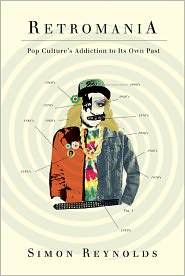
That’s All, Folks! A look at Simon Reynolds’ Retromania
As an art student in the late nineties, I was required to attend art history lectures once a week. Sitting in that dark auditorium on Wednesday mornings I would stare at the enormous slide projections and listen while professors narrated the story of humanity’s creative evolution — from cave paintings to abstract expressionism and minimalism. And afterwards, stepping out into the bright streets, it usually took a while for my eyes to adjust, but one impression that stayed with me and still does is the overwhelming sense that we may be at “the end of art history.”
It’s all been done before. Maybe you’ve heard this from your parents. Today’s music is nothing compared to the music of the 60’s. In his book, Retromania: Pop Culture’s Addiction to Its Own Past, Simon Reynolds is siding with parents everywhere. If you’ve bothered to notice the lack of musical innovation in the recent past then you have to read this book. And if you haven’t noticed, then you may not be paying enough attention. Reynolds puts forward a well-balanced and detailed argument, and after 400+ pages it’s hard not to agree with him. Has any musician created anything truly innovative in the past ten years? Animal Collective, you say? (Beach Boys meets club music.) The White Stripes? (Stones/Zeppelin garage rock throwbacks.) According to Reynolds, there aren’t many options left for artists besides recombining and reheating old ideas. And he feels we have exhausted that pursuit. He’s ready for a new genre to emerge but seriously doubts it will come from the American “hipster” class.
As a struggling musician striving to make art that has an impact, I found his critical observations of our culture spot-on. While he is clearly a fan of the music he writes about, Reynolds is not a glass-is-half-full kind of guy. He is a critic rather than a historian, but he displays an encyclopedic knowledge of the last forty years, covering many genres and influences on both sides of the Atlantic.
The lack of passion that pervades indie rock today is indicative of Western culture’s current bland state. We have a surplus of generic re-combinations. Imitators masquerading as original voices. We have too many choices. You don’t want Brand X cola, you want Coke. But according to Reynolds, all we get today is Brand X — generic imitations of original flavor. He even goes so far as to equate music’s current crisis to the one in the financial sector – predicting that this bubble will inevitably bust if we keep repackaging and reselling the same bad debt.
Born in 1963, the year Reynolds claims was coincidentally the birth of rock as artform, he is admittedly partial to 70’s punk as well as the rave scene of the 90’s – both of which get more attention than other areas, but he covers just about everything. Historically speaking, Reynolds points out the split that occurred around the time that The Beatles’ Sgt. Peppers album came out – ushering in a new era of sophisticated rock, which fueled 70’s prog-rock as well as the jamband world of virtuosos that we have today.
Jamband aficionados will appreciate mention of The Grateful Dead’s Grayfolded project — the weaving together and layering of several decades of Dark Star, which ties into his thesis of technology’s effect on creativity and our watered down, thinned-out, thirst to simultaneously experience “everywhen.” He also identifies the Deadheads’ obsession with capturing the moment through live recordings as another symptom of this obsessive cataloguing and preserving the past, rather than a striving for the future, which heroes of the past were actually doing.
Retromania is a book that I often read with my iPod handy, so I could occasionally look up some of the artists he mentions that I hadn’t heard of. (At times I thought it would make a good BBC style radio series.) In fact, one of the best chapters examines the iPod and how it may be the closest thing to a revolutionary force in music that society has produced in the past ten years. This is an important point. The iPod has trumped the artist, Reynolds explains. “The media is the message.”
Another highlight was the chapter on YouTube and his examination of the obsessive curating of culture that takes place daily on that site and others. It reminded me of my recent discovery of the Phish “Twibe” on Twitter — which has become a platform for Phish followers to document every word that comes out of Trey’s mouth on stage in excruciating detail, or catalogue how many hours each live performance of a song has clocked to date. This is obsessive compulsive behavior, and Reynolds never tires of pointing out our society’s narcissistic self-regard.
The cult of Retromania has parallels in the art and fashion world, and chapters on these aspects of culture add a refreshing perspective. Using Brian Eno as an example, Reynolds paints a picture of the contemporary artist as curator rather than innovator. Artist as collector/curator is a theme that plays out on several different levels.
Our primary achievement in the last decade has been with inventing new ways of recombining the past. Like those on the social networks, musicians have also become custodians of culture. DJ’s make a name for themselves by their creative choices, which amounts to glorified plagiarism, creativity reduced to “taste games.” While the popularity of collage art goes back at least to surrealism, the blurring of genres is something that jamband fans and festival goers are already familiar with. Recently, while I was reading the book, I couldn’t help but notice a “Pretty Lights vs. Led Zeppelin” video appeared on this site. I saw Pretty Lights play at this summer’s All Good Music Festival, headlining alongside Furthur (oddly mashed-up combinations like this are now commonplace at summer festivals). Though Pretty Lights’ late night set drew a younger crowd, I was surprised to see that the DJ has truly reached rock star status — something Reynolds notes in his book.
Taking something somebody else made and calling it art has been popular since Duchamp put a toilet on a pedestal. (In fact, John Lennon’s toilet sold at auction for a staggering $15,000, I learned in this book, but I’ll let Reynolds tell you the bizarre story of what became of the urinal that used to reside inside CBGBs men’s room.)
There is perhaps some lamenting here, some nostalgia for a lost past, for the golden age of “yesterday.” Writing, after all, is also a form of re-membering. Writers mine the past and present in search of meaning. With everyone blogging and texting and commenting on the web, this may just be a time of collective reflection and examination in our society. Or it may signal the end of American cultural dominance, something Reynolds hints at in his conclusion but doesn’t provide much support for. Though it seems to go on a bit long in sections (the exhausting footnotes were a bit annoying), it really was a great read, and as an artist, it didn’t discourage me as much as it seemed to poke me with a stick and demand I look for new avenues that haven’t already been exploited. Retromania encourages readers everywhere to wake up and notice the pervading presence of “everywhen” that threatens to drown out the future of popular music.



No Comments comments associated with this post